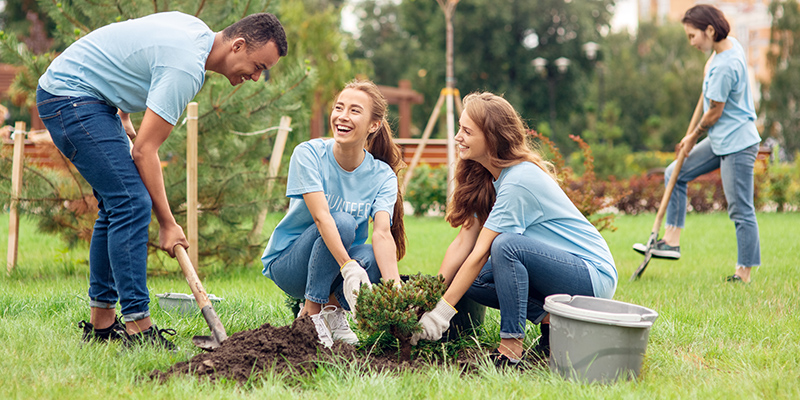An HOA community garden is a great way to engage residents and add some life to the neighborhood at the same time. But, how exactly do you start one?
The Benefits of Creating an HOA Community Garden
Gardening has become a popular activity in the United States. In fact, in 2020 alone, more than 39 million households participated in vegetable gardening. This is a sharp increase from 2019 when only 31.9 million households took up the activity.
But, not everyone has enough room on their property to grow vegetables, herbs, and flowers. Plus, for homes in HOA communities, there may be landscaping rules that prevent owners from taking full advantage of their yards. This is where an HOA community garden comes in.
More and more homeowners associations are taking the leap to create community gardens in their neighborhoods. The move sometimes is borne out of a need to use extra space; other times, it’s a result of an HOA’s eco-friendly initiative. Whatever the case may be, a community garden in your HOA can have several advantages.
Here are the top reasons why you should look into getting your own community garden up and running.
1. Good Exercise for Residents
Gardening is an excellent way to get some much-needed sunlight and sweat it out. In other words, it makes for good exercise. A community garden encourages residents to spend time outdoors, roll up their sleeves, and use some elbow grease. While not exactly a strenuous activity, gardening can still manage to get the heart pumping. Plus, it gives residents an opportunity to learn about different types of plants and how they grow.
2. Adds Beauty and Functionality
 A community garden can enhance the appeal of the neighborhood. Simple landscaping does wonders to make concrete sidewalks look great. Can you imagine what a whole bed of colorful flowers and vegetables can do?
A community garden can enhance the appeal of the neighborhood. Simple landscaping does wonders to make concrete sidewalks look great. Can you imagine what a whole bed of colorful flowers and vegetables can do?
In addition to beauty, an HOA garden is also very functional. Residents can save money on fresh produce if they plant vegetables and herbs. They can even share the fruits of their labor with other neighbors or sell their harvest at a weekend market.
3. An Eco-Friendly Use of Space
An HOA community garden is the perfect solution if you have a plot of land that isn’t quite big enough for a new amenity. Instead of another dull concrete space, why not breathe new life into the area by filling it with plants? A garden is not only beautiful but also very eco-friendly.
4. An Opportunity to Grow as a Community
Far too many associations fail at homeowner participation. It’s tough to get people interested in HOA activities. But perhaps your community just isn’t hosting the right ones.
A community garden encourages homeowners to get involved in a more hands-on manner. Because plants need care and attention, residents are more likely to be invested in the activity from start to finish. Furthermore, it gives people a chance to socialize outside of simple hellos at HOA functions. A garden can grow relationships and allow residents to feel a sense of community.
How to Start a Community Garden in Your HOA
The benefits of a community garden are enough to sway anyone. But starting your garden may not be as clear-cut a process as you’d like it to be. Here are the steps on how to make a community garden in your HOA.
1. Gauge Interest
 The first thing you must do is check whether or not there is a demand for a garden in your community. There’s no use in starting a community garden if no one’s going to sign up for it. To gauge resident interest, conduct a survey either online or in person. You can even include it as part of your agenda for the next board meeting. Understanding the level of interest will help you prepare for the next step.
The first thing you must do is check whether or not there is a demand for a garden in your community. There’s no use in starting a community garden if no one’s going to sign up for it. To gauge resident interest, conduct a survey either online or in person. You can even include it as part of your agenda for the next board meeting. Understanding the level of interest will help you prepare for the next step.
2. Find a Suitable Plot of Land
Building a community garden doesn’t just take interest and determination — it requires real estate. You can’t start a garden if you don’t have the space for it. When looking for a plot of land for your garden, consider location, size, and soil condition. You will likely need to prepare the plot to get it ready for plant growth. Not all soil works well for gardening.
3. Establish Fees
An HOA community garden doesn’t take care of itself. While residents are responsible for their plots, the association should make proper preparations and maintenance. This includes redoing the dirt, setting up an irrigation system, and the like. And these things don’t come for free.
An HOA can charge a reasonable annual fee to cover the cost of maintaining the garden. Something like $50 per year per plot is a good start. But it depends on the budget and how many plots you will have for allocation. Keep in mind that you should only charge the fee to residents who end up participating in the project.
4. Create HOA Community Gardening Rules
Rules can be tedious and irritating, but they are necessary. Gardening policies help maintain order and cleanliness. They outline the exact responsibilities of residents.
Some of the rules you should consider include:
- Determine how often owners must remove weeds from their plot
- Prohibit owners from leaving their gardening tools unattended
- Prohibit pets from the premises
- Restrict the types of plants owners can grow
Make sure to distribute these rules to all garden owners and have them posted in the gardening area. This way, owners can’t make up an excuse and say they weren’t aware of the rules.
5. Convert
Once you’ve gone through the first four steps, it is time to turn the space into a community garden. This will require help from a professional landscaping company. Don’t attempt to do it yourself. You may end up making irreversible mistakes and ruin the entire operation.
6. Educate and Share
 The final step is to educate and share. Give owners gardening tips and distribute how-to guides. You may even want to consider hosting a seminar for beginner gardeners. Residents are more likely to continue participation if they succeed in their efforts, so you want to do everything you can to help them get there.
The final step is to educate and share. Give owners gardening tips and distribute how-to guides. You may even want to consider hosting a seminar for beginner gardeners. Residents are more likely to continue participation if they succeed in their efforts, so you want to do everything you can to help them get there.
Sharing is also a big part of gardening in a community. If your HOA has a social media page, consider posting photos of the garden and various progress stages with permission from the owners. Residents will feel more appreciative of the community and may even be inspired to participate in the garden themselves the following year.
Getting Started
As you can see, an HOA community garden doesn’t just bring added appeal and functionality — it brings people together. Now is the time to act if you want to start your own. Spring is just around the corner.
Condo Manager provides automated management solutions to community associations and HOA management companies. Call us today at (800) 626-1267 or contact us online for a free demo!
RELATED ARTICLES:
- 9 Valentine’s Day Ideas For Seniors In Your Community
- A Guide For Homeowners Who Want Architectural Changes In HOA Homes
- Know Your HOA Pet Policy To Avoid Issues



